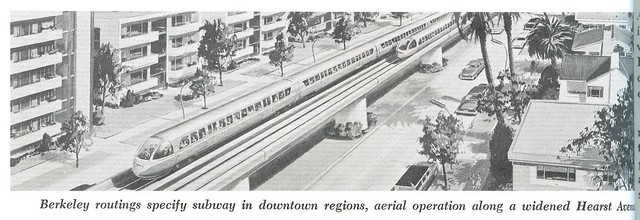Go ahead and react. We've been hearing this pejorative label since shortly after the residents of the peninsula voted overwhelmingly in support of the California high speed rail bond. Wealthy residents of Palo Alto, Atherton, and Menlo Park don't want the fast train in Their Back Yards, and so want to scuttle the voter-mandated line to San Francisco. Inexperienced, politically-connected HSR Board members are literally railroading peninsula citizens with a bloated, ill-planned waste of taxpayer dollars. Pick a side, you're either fer it or agin' it.
This argument has gotten unnecessarily heated. Remember, folks, we're all neighbors and our success as cities depends in many ways on our success as a region, which in turn depends on us working together. If that seems too hard to do, let's take a step back and look at how other people managed to work out a very similar conflict right here in the Bay Area.
Elevated BART tracks in Berkeley, image via Eric Fischer's Flickr stream
In the 1960s, when BART was forming its plans to run rapid transit trains through San Francisco, Alameda, and Contra Costa Counties, it became clear that the agency didn't have enough money to dig tunnels beneath every urban area through which the system ran. Instead, to meet the grade separation requirements, most of the less dense areas would get elevated tracks and stations. Sound familiar so far?Residents of Berkeley didn't want the elevated structures to blight their streets, and opposed those plans. They had a point, elevated structures can lower the quality of public space, darkening streets and conducting sound from the noisy trains. But in order for BART to be an effective system, its trains had to cross Berkeley and connect Richmond and Concord with downtown SF. Its priorities were to reach more people, not guarantee a peaceful quality of life for neighbors. You still with me?
That's there the parallels end, however. Rather than fight to stop BART construction, the city of Berkeley passed a bond, raising its own money to pay for the tunneling within its borders. And their investment has paid off The areas near BART's route through Berkeley don't suffer from the same problems that plague Oakland's elevated tracks and stations right down the street, and the Bay Area has reaped the benefit of our regional rapid transit system for decades now.
I am a strong supporter of High Speed rail, and I think it's important that we build the best system we can. That means providing the best, fastest service from SF to LA without unnecessarily impacting people who live along the way. The CAHSR board doesn't want to run trains on elevated tracks over San Mateo County because it hates Palo Altans or finds train viaducts beautiful, it just doesn't have the money to dig tunnels.
Palo Alto, Atherton, Menlo Park, and any other cities along the tracks have a right to be concerned about what gets built in their back yards. As a resident of SF I have opinions about the alignment here in the city, and the opportunity we have to improve transportation connectivity and the public realm in the Eastern part of town. If a city wants a more expensive alternative to the alignment than the one CAHSR selects, it should be able to get it provided 1) the city comes up with the money to pay for it and 2) it doesn't impact future train service.
The so-called Peninsula NIMBYs happen to be in some of the wealthiest communities in California. It's entirely appropriate for them to pay to gild this infrastructure that our state can't afford not to build.






No comments:
Post a Comment